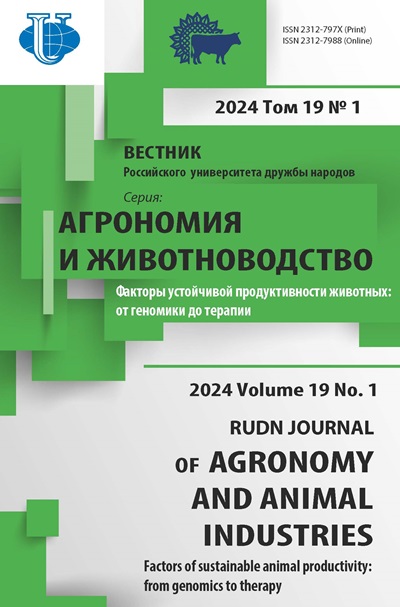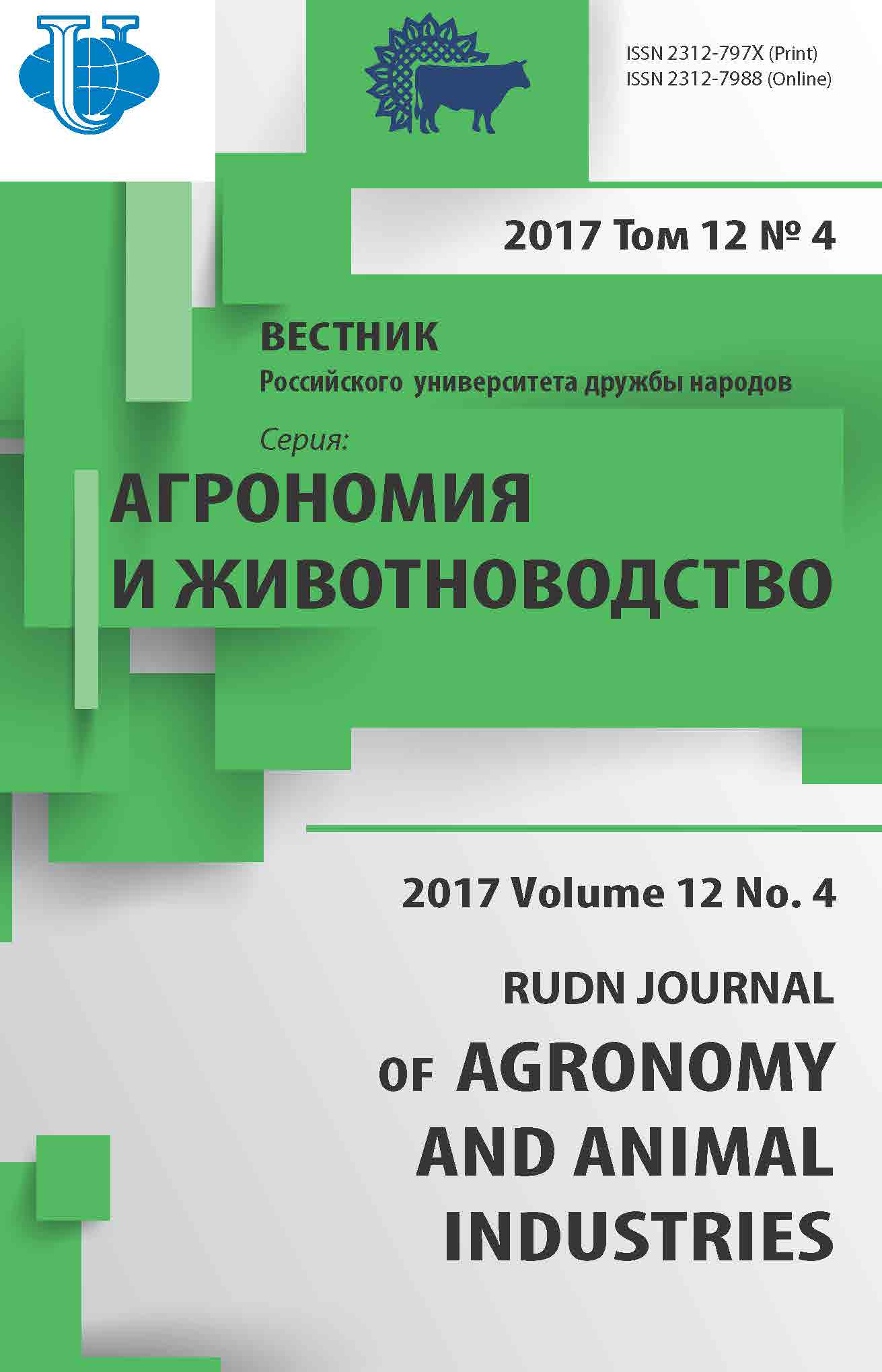REGULATION OF THE WATER REGIME OF PEAT EARTH MECHANICAL LOW-DIRECTION BY SCALING
- Authors: Poddubsky AA1, Zakharova OA2, Evsenkin KN3, Shuravilin AV1
-
Affiliations:
- Peoples’ Friendship University of Russia (RUDN University)
- FGBOU VO “Ryazan State Agrotechnological University named after P.A. Kostycheva”
- FGBNU All-Russian Scientific Research Institute of Hydraulic Engineering and Land Reclamation
- Issue: Vol 12, No 4 (2017)
- Pages: 341-349
- Section: Articles
- URL: https://agrojournal.rudn.ru/agronomy/article/view/17477
- DOI: https://doi.org/10.22363/2312-797X-2017-12-4-341-349
Cite item
Full Text
Abstract
On peatlands annually in sunny weather there is a drying and self-ignition of the upper layer due to the cessation of the flow of groundwater during the rupture of the capillary rim and the violation of the water-lifting capacity. On drained peat soils, groundwater plays a major role in the fire-fighting plan and water and mineral nutrition of plants. One of the ways to maintain groundwater at the optimal level is the sluicing. It is most effective at groundwater objects, in the presence of well permeable soils. In this case, moistened land has a slight bias and when it is possible to supply water to the soil in the required quantities to cover the costs of evaporation, transpiration. At the same time, many issues related to the regulation of the water regime of peat soils by flooding remain unexplored, so the topic of our research is relevant and of great importance for the subsequent agricultural use of these soils. The aim of the work is to study the water regime of peat soils in the Mescher lowland and the scientific justification for its regulation by sluicing. Full-scale field experiment was carried out on peat soils of the Meshcherskaya lowland in the Polkovo collective farm of the Ryazan region of the Ryazan region in 2012-2016. With options for standard dehumidification, sluicing 0.5 m and 0.8 m. The control was a site on a low marsh. The methods of research and technology of cultivating annual grasses (vetch-oat mixture on green forage) are generally accepted. To more accurately describe the processes of locks, the characteristics of soil mois-ture, the assessment of changes in water balance items in the model, thermodynamic and geosystemic (landscape) approaches are used. We used the mathematical model of moisture transfer “Shlyuzovanie”, developed by A.I. Golovanov and Yu.I. Sukharev with the introduction into it of the terrain of the pilot site. In our forecast calculations, the depth of the systematic drains was assumed to be 1.0 ... 1.2 m, the en-closing network (trap drains) was assigned within the limits of 1.2 ... 1.4 m. We established that the results depend on the variant of sluicing, weather conditions, regular A decrease in the depth of groundwater and an increase in peat moisture with rising levels in canals. It was found that when the water level in the canal is raised to 0.8 m and up to 0.5 m from the edge, the depth of groundwater decreases from 0.85 to 0.58 m, and the humidity in the 0 ... 25 cm layer increases from 63 to 74% Porosity. Shlyuvanie with rising water level in the canals to 0.5 m provides sufficient fire-fighting humidity, but is associated with a significant water consumption - almost twice as large and with a marked decrease in the productivity of crops - up to 25% than with a slip of 0.8 m. As a result Five-year field experiments, the processes of sluicing of the dried peat bog in fire-fighting purposes have been studied and it is established that, as applied to the conditions of the experimental plot, the rise in the water level in the channel to a depth of 0.40 m from the edge provides the moisture of the upper layer fyanika in the dry period of about 0.59 share porosity, that is fire safety. For the climatic conditions of the Meshcherskaya lowland, a “soft” sluice with a rise in the water level in the canals to 0.8 m from the surface of the earth proved to be sufficient in the fire resistance.
Keywords
About the authors
A A Poddubsky
Peoples’ Friendship University of Russia (RUDN University)
Author for correspondence.
Email: a.poddubsky@mail.ru
Поддубский Антон Александрович - кандидат технических наук, доцент агроинженерного департамента Аграрно-технологического института Российского университета дружбы народов
Miklukho-Maklaya st., 6, Moscow, Russia, 117198O A Zakharova
FGBOU VO “Ryazan State Agrotechnological University named after P.A. Kostycheva”
Email: ol-zahar.ru@yandex.ru
Захарова Ольга Алексеевна - доктор сельскохозяйственных наук, доцент кафедры агрономии и агротехнологий ФГБОУ ВО «Рязанский государственный агротехнологический университет имени П.А. Костычева»
st. Kostycheva, 1, Ryazan, Russia, 390041K N Evsenkin
FGBNU All-Russian Scientific Research Institute of Hydraulic Engineering and Land Reclamation
Email: kn.evsenkin@yandex.ru
Евсенкин Константин Николаевич - кандидат технических наук, ведущий научный сотрудник ФГБНУ Всероссийский НИИ гидротехники и мелиорации им. А.Н. Костякова
A.N. Kostyakov str. The big academic, 44-2, Moscow, RussiaA V Shuravilin
Peoples’ Friendship University of Russia (RUDN University)
Email: stanislavpiven@mail.ru
Шуравилин Анатолий Васильевич - доктор сельскохозяйственных наук, профессор агроинженерного департамента аграрно-технологического института Российского университета дружбы народов
Miklukho-Maklaya st., 6, Moscow, Russia, 117198References
- Bushuyev, N.N. Modern methods of soil-ecological monitoring / N.N. Bushuev, A.V. Shuravilin, Т.V. Papaskiri, A.Yu. Soshnikov, B.E. Bondarev, V.I. Kuznetsov, V.V. Borodychev, A.V. Levina. Land management, cadastre and land monitoring, 2009. No. 9 (57). P. 44—49.
- Armor, B.A. Methodology of field experience. M.: Kolos, 1973. P. 15—40.
- Zakharova, O.A., Costin Ya.V. The regime of organic matter in meliorated soil. Ryazan, RGATU, 2013. 116 p.
- Mazhaysky, Yu.A. Ecologization of water use in the reclamation of floodplain lands. In the collection: “Man and the Environment”: Proceedings of the Fourth Republican Scientific Conference / Yu.A. Mazhaysky, T.M. Gusev, V.F. Evtyukhin, K.N. Evsenkin, V.A. Ignatyuk, V.F. Gorbich. Ryazan, 2000. P. 75—85.
- Muromtsev, N.A. Ground water as a source of water and mineral nutrition of plants / N.A. Muromtsev, N.A. Semenov, Yu.A. Mazhaysky, P.I. Pylenok, A.V. Shuravilin, K.B. Anisimov // In the collection: “Soil and Land Resources: Status, Evaluation, Use”: Proceedings of the First All- Russian Open Conference. M., 2015. P. 511—515.
- Ovchinnikov, A.S., Borodychev V.V., Poddubsky A.A., Shuravilin A.V. Substantiation of the need for reclamation taking into account agroclimatic indicators. News of the Nizhnevolzhsk Agro- University Complex: Science and Higher Vocational Education. Volgograd, 2016. No. 4 (44). P. 15—24.
- Semenova, K.S. Substantiation of fire-prevention flooding of drained peatlands in the Meshcherskaya lowland conditions: Abstract on the sisk. uch. st. kt. n. on spec. 06.01.02 — Reclamation, reclamation and protection of lands. M., 2016. 24 p.
- Shuravilin, A.V., Kibek A.I. Melioration. Moscow: EKSMOS, 2006. 944 p.
- Bray, G.A. Afferent signsls regulating food intake. Prog. Nutr. Soc. 2000. V. 59. No. 3. P. 373— 384.
















